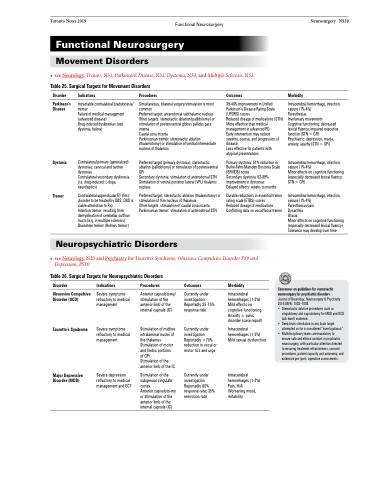Page 837 - TNFlipTest
P. 837
Toronto Notes 2019 Functional Neurosurgery Functional Neurosurgery
Movement Disorders
• seeNeurology,Tremor,N31,Parkinson’sDisease,N32,Dystonia,N33,andMultipleSclerosis,N52 Table 25. Surgical Targets for Movement Disorders
Neurosurgery NS39
Morbidity
Intracerebral hemorrhage, infection, seizure (1%-4%)
Paresthesias
Involuntary movements
Cognitive functioning: decreased lexical fluency, impaired executive function (STN > GPi)
Psychiatric: depression, mania, anxiety, apathy (STN > GPi)
Intracerebral hemorrhage, infection, seizure (1%-4%)
Minor effects on cognitive functioning (especially decreased lexical fluency; STN > GPi)
Intracerebral hemorrhage, infection, seizure (1%-4%)
Paresthesias/pain
Dysarthria
Ataxia
Minor effects on cognitive functioning (especially decreased lexical fluency) Tolerance may develop over time
Disorder
Parkinson’s Disease
Dystonia
Tremor
Indications
Intractable contralateral bradykinesia/ tremor
Failure of medical management (advanced disease)
Drug-induced dyskinesias (see dystonia, below)
Contralateral primary (generalized) dystonias; cervical and tardive dystonias
Contralateral secondary dyskinesia (i.e. drug-induced: L-dopa, neuroleptics)
Contralateral appendicular ET (first disorder to be treated by DBS; DBS is viable alternative to Rx) Intentiontremor resultingfrom demyelination of cerebellar outflow tracts (e.g. in multiple sclerosis) Brainstem tremor (Holmes tremor)
Procedures
Simultaneous, bilateral surgery/stimulation is most common
Preferred target: anterodorsal subthalamic nucleus Other targets: stereotactic ablation (pallidotomy) or stimulation of posteroventral globus pallidus pars interna
Caudal zona incerta
Parkinsonian tremor: stereotactic ablation (thalamotomy) or stimulation of ventral intermediate nucleus of thalamus
Preferred target (primary dystonia): stereotactic ablation (pallidotomy) or stimulation of posteroventral GPi
Secondary dystonia: stimulation of anterodorsal STN Stimulation of ventral posterior lateral (VPL) thalamic nucleus
Preferred target: stereotactic ablation (thalamotomy) or stimulation of Vim nucleus of thalamus
Other targets: stimulation of caudal zona incerta Parkinsoniantremor:stimulationofanterodorsalSTN
Outcomes
39-48% improvement in Unified Parkinson’s Disease Rating Scale (UPDRS) scores
Reduced dosage of medications (STN) More effective than medical management in advanced PD
Early intervention may reduce severity, course, and progression of disease
Less effective for patients with atypical presentations
Primary dystonia: 51% reduction in Burke-Fahn-Marsden Dystonia Scale (BFMDS) score
Secondary dystonia: 62-89% improvement in dystonias
Delayed effects: weeks to months
Durable reductions in essential tremor rating scale (ETRS) scores
Reduced dosage of medications Conflictingdataonvocal/facialtremor
Neuropsychiatric Disorders
• seeNeurology,N20andPsychiatryforTourette’sSyndrome,ObsessiveCompulsiveDisorderPS9and Depression, PS10
Table 26. Surgical Targets for Neuropsychiatric Disorders
Disorder
Obsessive Compulsive Disorder (OCD)
Tourette’s Syndrome
Major Depressive Disorder (MDD)
Indications
Severe symptoms refractory to medical management
Severe symptoms refractory to medical management
Severe depression refractory to medical management and ECT
Procedures
Anterior capsulotomy/ stimulation of the anterior limb of the internal capsule (IC)
Stimulation of midline intralaminar nuclei of the thalamus Stimulation of motor and limbic portions of GPi
Stimulation of the anterior limb of the IC
Stimulation of the subgenual cingulate cortex
Anterior capsuloto-my or stimulation of the anterior limb of the internal capsule (IC)
Outcomes
Currently under investigation Reportedly 25-75% response rate
Currently under investigation Reportedly >70% reduction in vocal or motor tics and urge
Currently under investigation Reportedly 60% response rate; 35% remission rate
Morbidity
Intracerebral hemorrhages (1-2%) Mild effects on cognitive functioning Anxiety ± panic disorder (case report)
Intracerebral hemorrhages (1-2%) Mild sexual dysfunction
Intracerebral hemorrhages (1-2%) Pain, H/A Worsening mood, irritability
Consensus on guidelines for stereotactic neurosurgery for psychiatric disorders Journal of Neurology, Neurosurgery & Psychiatry 2014;85(9): 1003–1008.
• Stereotacticablativeproceduressuchas cingulotomy and capsulotomy for MDD and OCD lack level I evidence.
• Deepbrainstimulationinanybraintarget attempted so far is considered “investigational.”
• Multidisciplinaryteamsaremandatoryto ensure safe and ethical conduct in psychiatric neurosurgery, with particular attention directed to ensuring treatment refractoriness, consent procedures, patient capacity and autonomy, and extensive pre-/post- operative assessments.


